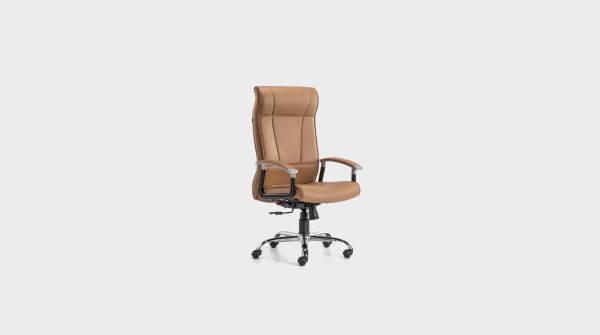When we spend long hours at our desks, the impact of poor posture and inadequate support becomes increasingly evident. While many people focus on ergonomics in general, few realize just how crucial a well-designed executive desk chair can be for spinal health. The right chair isn’t just about aesthetics or comfort, it’s a daily investment in your long-term well-being. In this blog, we’ll explore how a good chair can make all the difference, both physically and mentally, especially when it comes to maintaining healthy posture and spine alignment.
The Science Behind Sitting and Spinal Alignment
The human spine has a natural S-curve that balances our body and allows for a range of movements. When you sit, particularly for long stretches, you risk flattening or exaggerating this natural curve, which can lead to chronic back pain, stiffness, and muscular imbalances. If your chair doesn’t support this curve properly, especially in the lumbar region, the consequences can compound over time.
A well-engineered chair addresses these concerns with targeted support. High-quality executive desk chairs are designed not only to cradle your body but to encourage a neutral posture where your head, shoulders, and hips are aligned. This reduces unnecessary strain and allows your muscles to relax instead of compensating for poor alignment.
Key Features That Promote Spinal Health
Not all chairs are created equal. When shopping for a chair that supports spinal health, you need to look for a few specific features that directly influence how well your posture is maintained throughout the day:
1. Lumbar Support
Proper lumbar support ensures that the natural inward curve of your lower back is preserved. A lack of this feature is often the culprit behind nagging lower back pain. A chair with adjustable lumbar support allows you to fine-tune the positioning based on your body structure.
2. Seat Depth and Width
An ideal seat should support most of your thighs without pressing against the back of your knees. A shallow seat can force your spine to round forward, while a seat that’s too deep can cut off circulation or push your posture out of alignment.
3. Adjustable Height
When your feet rest flat on the floor with your knees at a 90-degree angle, your pelvis remains in a neutral position. Adjustable height ensures that people of various statures can use the same chair effectively, preserving that essential alignment.
4. Recline Functionality and Tension Control
Contrary to what some may believe, sitting completely upright all day isn’t ideal. A slight recline (up to 135 degrees) reduces spinal disc pressure. Good executive desk chairs offer this feature, letting you lean back comfortably while maintaining support.
5. Armrest Adjustability
Adjustable armrests reduce tension in the shoulders and neck, helping you avoid slouching or hunching forward. This feature is especially useful for those who spend a lot of time typing or reading at a desk.
Psychological and Physical Benefits of a Well-Supported Spine
The advantages of choosing the right chair extend beyond mere physical comfort. A chair that encourages good posture can lead to better concentration, reduced fatigue, and a boost in mood. Physical discomfort is a major distraction, remove that obstacle, and you’re likely to see a marked improvement in productivity and mental clarity.
Poor posture, on the other hand, can affect everything from breathing patterns to digestion, and over time, even your confidence. Correct posture exudes professionalism and assurance, both of which are subtle yet impactful traits in the workplace.
How to Tell If Your Current Chair Is Hurting Your Spine
You may not even realize that your current chair is doing more harm than good. Here are a few telltale signs:
- Frequent lower or mid-back pain
- Tingling or numbness in your legs
- A constant urge to shift or fidget
- Headaches caused by strained neck muscles
- A slouched or rounded back after short periods of sitting
If you recognize any of these symptoms, it might be time to reassess your setup. Upgrading to a supportive high back office desk chair could be the game-changer you didn’t know you needed.
Not All Executive Desk Chairs Are Equal
It’s easy to be swayed by looks when selecting a chair, especially with sleek designs flooding the market. But aesthetics shouldn’t come at the cost of function. While style matters, prioritize construction, adjustability, and ergonomics.
Materials like memory foam or breathable mesh can enhance comfort over long periods, while a sturdy frame ensures durability. Choose models that are certified for ergonomics, tested for weight capacity, and praised in user reviews for providing lasting comfort and support.
Choosing the Right Chair for Your Body Type
Every individual is built differently. What works for a colleague may not suit you. Ideally, test the chair in person or buy from a retailer that offers a generous return or trial policy. Pay attention to how your body feels after sitting for a while. Do you feel supported, or are you subconsciously shifting to avoid pressure points?
Some executive desk chairs also offer personalized adjustment from lumbar depth to seat tilt and tension controls, that allow you to customize your seating experience. This level of personalization can be crucial for those with pre-existing back conditions.
Practical Tips for Maximizing Your Chair’s Benefits
Even the best chair can’t compensate for poor habits. Here are a few daily practices that will help you maintain good posture:
- Take Regular Breaks: Stand up and stretch every 30 to 60 minutes.
- Adjust Your Screen Height: Your monitor should be at eye level to avoid neck strain.
- Mind Your Foot Position: Always keep your feet flat on the ground or on a footrest.
- Avoid Crossing Legs: It can misalign your pelvis and spine.
- Strengthen Core Muscles: Exercises like planks or bridges improve posture by stabilizing your spine.
Final Thoughts
Your chair is more than just a place to sit, it’s an integral part of your daily health equation. With long hours spent at a desk becoming the norm, the importance of spinal support cannot be overstated. Investing in the right executive desk chair is a step toward preventing chronic issues, improving focus, and enhancing your overall work experience.
So the next time you browse for furniture, think beyond appearances. Choose a high back office desk chair that not only complements your workspace but actively supports your health. Your spine and future self will thank you.











